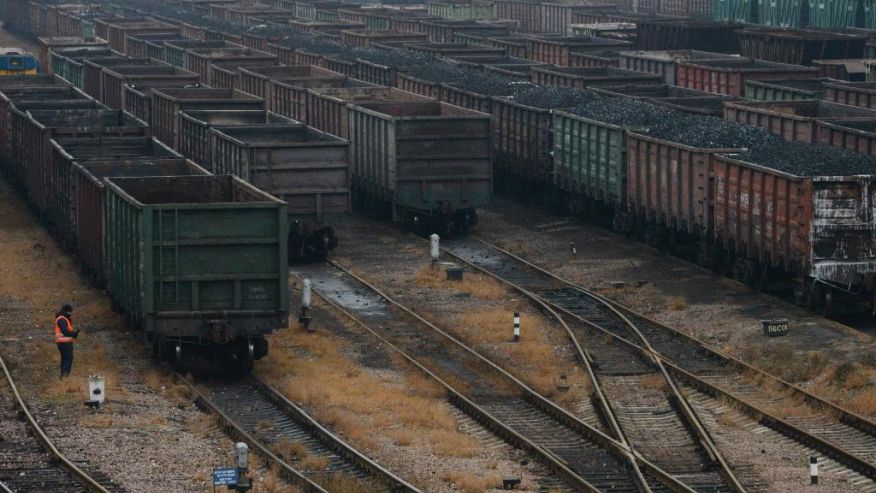
Ukraine Turns to Russia in Energy Crisis
Publication: Eurasia Daily Monitor Volume: 12 Issue: 6
By:

Weakened by a war with Russia-backed militants, Ukraine has been living through an energy crisis of proportions unseen since the 1990s. Blackouts began across the country this past fall due to natural gas cutoffs from Russia and the suspension of coal supplies from eastern Ukrainian mining regions controlled by the insurgents. Consequently, the pro-Western government in Kyiv has had to reluctantly turn to Russia for energy. Kyiv’s strategy remains to cut dependence on Russia in the energy sphere, and Ukraine has succeeded to a certain extent in the natural gas sector. But it has proved more difficult to find alternatives to cheap Russian electricity to fill Ukraine’s shortfall.
After a break in June–November 2014, caused by a debt and pricing dispute, Ukraine resumed importing Russian natural gas in December as Ukraine’s gas reserves fell to a dangerously low level. According to a deal brokered by the European Union in October, Ukraine will import Russian gas at least until April 1, 2015 (Liga.net, October 31, 2014). However, for the first time since the country’s independence, Ukraine produced more gas last year than it imported, and imports from Russia plunged to 14.5 billion cubic meters (bcm) of gas, from 25.8 bcm in 2013. Whereas, Ukraine’s gas imports from the EU jumped to 5.1 bcm in 2014, as compared to 2.0 bcm the previous year, according to preliminary data from the national gas pipeline operator Ukrtranshaz (Utg.ua, January 6, 2015).
The boost in imports of European gas became possible thanks to the opening of a pipeline route via Slovakia in September 2014, which Russia had long opposed. As a result, Ukraine imported 3.6 bcm of gas via Slovakia, as well as 0.9 bcm of gas via Poland and 0.6 bcm of gas via Hungary last year, buying gas from German, French and Norwegian companies (Utg.ua, January 5, 2015). Gas from the EU, even if much of it is originally Russian gas bought by European companies, is cheaper for Ukraine than buying directly from Russia’s Gazprom—this is due to the varying price levels Gazprom charges to its European consumers. In October 2014, gas imported by Ukraine from the EU cost $316 per 1,000 cubic meters on average, compared to the $378 Ukraine paid to Russia in December (Rian.com.ua, December 23, 2014).
One has to take into account that Ukraine could afford to cut natural gas imports last year because the recession caused Ukrainian industrial production to fall by 10 percent in January–November (Ukrstat.gov.ua, accessed on January 9, 2015). But when the economy rebounds, Ukraine will again have to import more gas. Meanwhile, a confluence of negative trends is forcing foreign energy sector investors to pull out of Ukraine. Among the culprits are Russia’s March 2014 annexation of Crimean gas fields, the recent Ukrainian tax hikes on oil and gas producers, and falling global energy prices. As a result, and lacking foreign investment capital, Ukraine has no funds or technologies to develop new fields in order to increase domestic production. Most recently, Chevron reportedly decided to quit a shale gas project in western Ukraine (Zn.ua, December 26, 2014), and the British company JKX suspended its capital investment program (jkx.co.uk, January 7).
Although Ukraine has depended on Russian gas for decades, it did not import Russian electricity in 2008–2013. Moreover, Ukraine produced enough power domestically to actually export electricity to neighboring countries. In 2013, Ukraine exported more than 5 percent of the total electricity it produced (Capital.ua, December 10, 2014; Forbes.ua, January 20, 2014). However, Ukraine has had to cut its exports this past year due to sweeping power shortages, by 14 percent in January–November, and 2.3 times year-on-year in November 2014 alone (Forbes.ua, December 22, 2014).
Ukraine has also cut power supplies to the Russia-annexed Crimean peninsula, which has always depended on mainland Ukraine for electricity. Kyiv used the issue of restoring electricity shipments to Crimea as a bargaining tool in its talks with Moscow. But as of November, Ukraine has had to turn to Russia for its own electricity needs. Russia agreed to sell electricity to Ukraine on the condition that Ukraine supply Crimea. Ukrainian President Petro Poroshenko announced on December 29 that Russia began supplying electrical power to Ukraine (UNIAN, December 29, 2014). Russian Energy Minister Aleksandr Novak specified that two contracts were signed, whereby Russia would supply power to Ukraine, and Ukraine would ensure “reliable and uninterrupted” current in Crimea (Minenergo.gov.ru, December 30, 2014).
Ukraine also has had to turn to Russia for coal to fuel its power plants. As a result, Kyiv now faces a difficult dilemma: On the one hand, Ukraine has been in a de facto state of war with Russia, and the domestic coal and electricity shortages have occurred directly because of that war. But on the other hand, Russian coal is much cheaper than the coal that Ukraine has begun to import from South Africa and is going to start importing from Australia and Vietnam, because of the transit distances involved (UNIAN, January 9, 2015). Ukraine is also eyeing coal from Kazakhstan, but the energy ministry says time is needed to negotiate prices (UNIAN, January 9, 2015).
Ukraine also wants to move away from its dependence on Russian nuclear power technologies. This is difficult, as all four of Ukraine’s nuclear plants were built according to Russian designs and use Russian nuclear fuel. However, nuclear diversification is necessary, as nuclear plants generate roughly half of Ukraine’s electricity—and in theory, Moscow could use this dependence to blackmail Kyiv. In December 2014, the US-based company Westinghouse and the Ukrainian nuclear power company Energoatom agreed that nuclear fuel deliveries to Ukraine would be “significantly increased” through 2020. Thus far, Ukraine has been using Westinghouse fuel at only one nuclear plant, South Ukraine (Westinghousenuclear.com, December 30, 2014).
The government in Kyiv does not intend to abandon the country’s various energy diversification projects. However, Russia is likely to remain the main source of imported energy for Ukraine in the foreseeable future.




